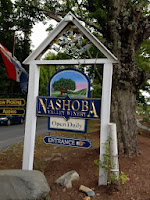 |
| Apple trees - you pick |
 |
| The vines |
Saturday, the day before the autumnal equinox, my husband and I went for a drive. We packed a picnic lunch and headed to the
Nashoba Valley Winery located in Bolton, MA. It turned out to be a bustling place. Many of the wines made here feature fruits other than grapes which result in a variety of delicious tastes. We took advantage of the opportunity to try a few of these unique wines.
Maiden's Blush is named after the apple from which it is made. Delightful for sipping as an aperitif. We simply had to have a bottle to take home. Our other purchase was
Marion made with grapes and blackberries. We decided to purchase those wines which were unique to this vineyard. You can get a Merlot or a Chardonnay anywhere. The experience was certainly an unusual one for New England, our last vineyard visit was in California. Unfortunately, when we were there it was March and the vines were bare, it was a pleasure to see green vines with fruit ripening.
 |
| Nashoba Valley Winery |
The best part of the day was watching the people who'd come to spend the day. There were lots of families picnicking and apple picking. The young couples out on a date, or like us, middle-aged couples who were finally free of parental obligations. Got to love the empty nest feeling (well almost - our son leaves for college next Fall but was away camping with the Boy Scouts). There was a group of six or seven girls (I call them girls because that's what they seemed to me) who were dressed to impress all wearing fashionable strappy flat sandals. Clearly they had come for the wine tasting and decided to stay to pick apples. I certainly thought their footwear wasn't appropriate for walking through the orchard, but then again I'm a middle-aged woman who spent five days in the hospital as the result of a tick borne illness (
anaplasmosis). You won't catch me walking through tall grass barefoot again.
 |
Window box outside of
J's Restaurant |
The vineyard even has a venue for hosting functions like the wedding that was going on smack dab in the middle of all of this hullabaloo. I hope the happy couple were well aware that the general public would be sharing the day with them. It was very romantic. If you can't afford to go off to California, Provence, or Tuscany I guess this could be the place for you.
 |
| J's Restaurant |
My only question is: Where are the big fences to keep out the deer? Do they have no deer in Bolton? The deer so love apples and other fruit. I remember that a friend of my father's (I grew up in Bolton, CT) was in the process of establishing a small vineyard of his own and was struggling with keeping the deer from decimating his vines. My father was successful in bagging at least one deer in order to keep the population from destroying the crop. Well the folks at Nashoba Valley Winery must be lucky that's all I can say. I have a few deer that I'd be happy to send down their way if it will keep them from eating all my hostas. Let's face it apples and grapes must taste so much better.



















